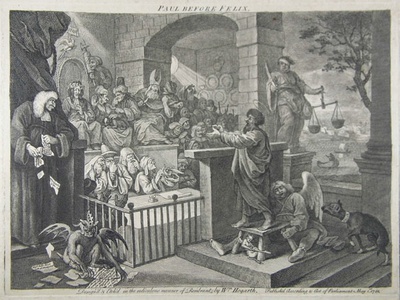| Method | Etching and mezzotint |
| Artist | William Hogarth |
| Published | Publish'd According to Act of Parliament May 1st. 1751 |
| Dimensions | Image 247 x 340 mm, Plate 260 x 348 mm, Sheet 282 x 360 mm |
| Notes |
A burlesque version of the biblical scene of St Paul declaiming before the Roman procurator of Judea, Marcus Antonius Felix, originally used as the subscription ticket for Hogarth's heroic scenes of Paul before Felix and Moses Brought to Pharaoh's Daughter. The burlesque itself was probably stimulated, in a Hogarthian display of business acumen and timely satire, by the recent imitations of Rembrandt executed by Benjamin Wilson, and sold successfully as Old Master prints to two of the leading connoisseurs of the age. Thus, Paul Before Felix Burlesqued is replete with imagery 'in the true Dutch taste.' Many of the figures are dressed in Dutch clothing, a wall at the back of the court is decorated with a display of Delftware, and in the distance a harbour scene features Dutch ships, houses, and a windmill. The central figure of Paul, haloed and wearing robes, stretches out his hands during an emphatic address on the nature of righteousness, temperance, and justice. His address is made from a stool, which a small horned devil attempts to topple by sawing through one leg. Paul's fat guardian angel slumbers, unaware of the dangers pressing in on his charge, while an evil-looking dog edges up behind Paul, his collar labelling him as 'Felix.' The actual Felix sits in his curule chair below the Eagle of the Senate and People of Rome. Despite the oak chaplet on his head, and the attendant with fasces to his right, he is dressed in the clothes of a contemporary judge. Paul's arguments have evidently scared Felix enough for the latter to have soiled himself, as the Jewish elders before him hold their noses in disgust and gesture mockingly, while Felix's wife turns away from her cringing husband. To his right, a High Priest, so incensed by Paul's speech, is being restrained from attacking him, a dagger in his hand. The scene is framed by two figures of mock justice. On the left, the prosecution tears up his speech as a winged devil tries to reassemble it. On the right, a fat figure of Justice peeks out from behind her blindfold. The inscription below reads: Design'd & Etch'd in the rediculous manner of Rembrant, by W:m Hogarth. William Hogarth (1697 - 1764) was born in London, the son of an unsuccessful schoolmaster and writer from Westmoreland. After apprenticeship to a goldsmith, he began to produce his own engraved designs in about 1710. He later took up oil painting, starting with small portrait groups called conversation pieces. He went on to create a series of paintings satirising contemporary customs, but based on earlier Italian prints, of which the first was The Harlot's Progress (1731), and perhaps the most famous The Rake's Progress. His engravings were so plagiarised that he lobbied for the Copyright Act of 1735, commonly referred to as 'Hogarth's Act,' as a protection for writers and artists. During the 1730s Hogarth also developed into an original painter of life-sized portraits, and created the first of several history paintings in the grand manner. Paulson 191 iii/v Condition: Small worm hole to centre of image. |
| Framing | unmounted |
| Price | £300.00 |
| Stock ID | 33991 |

